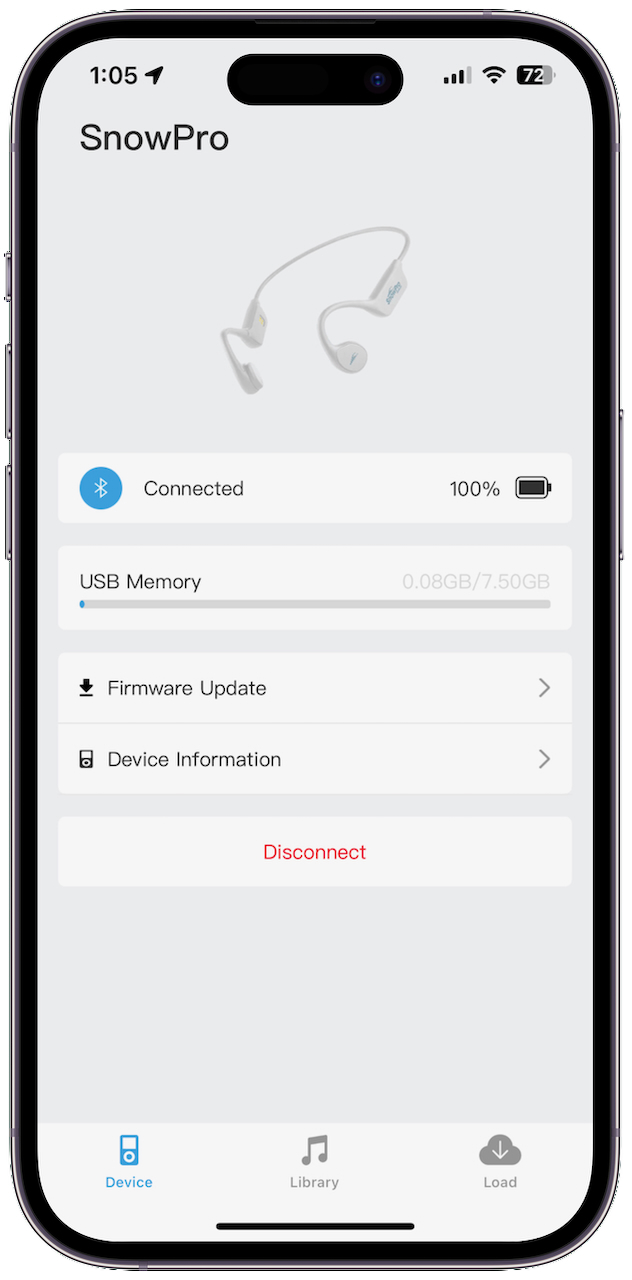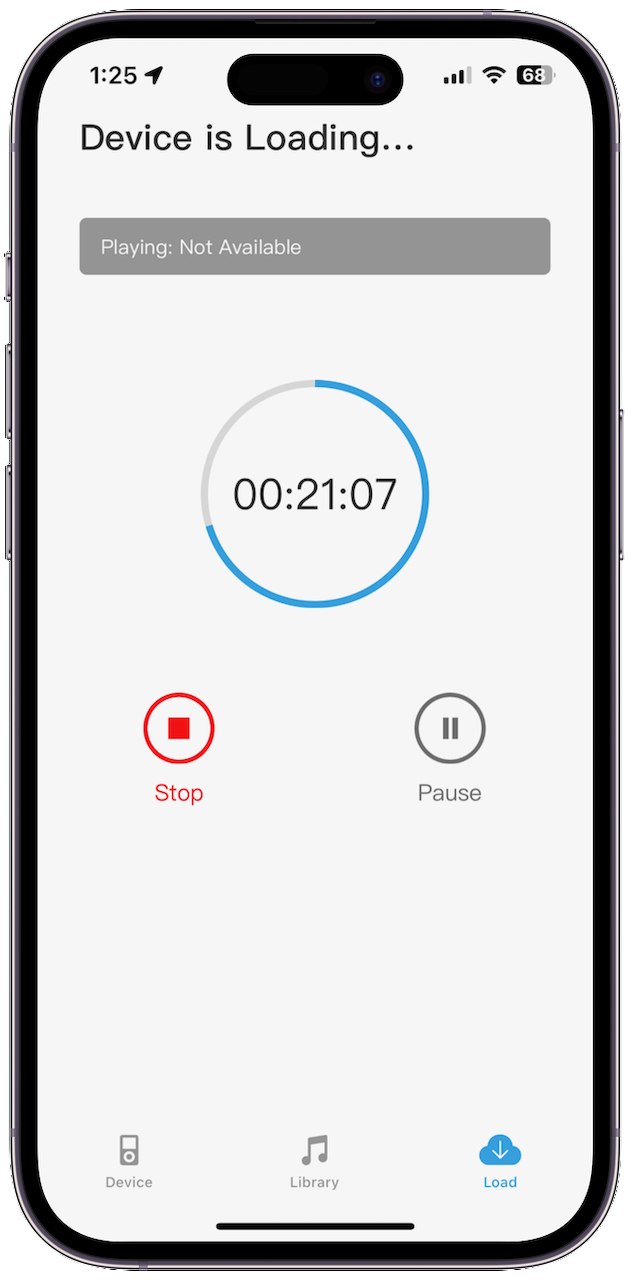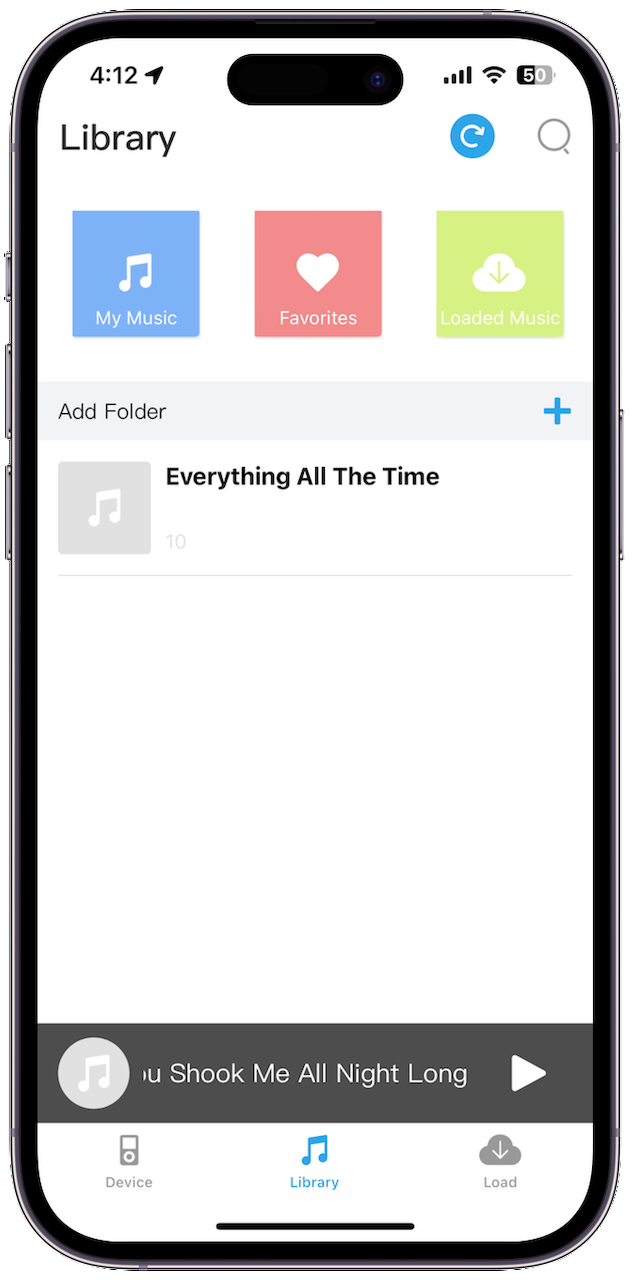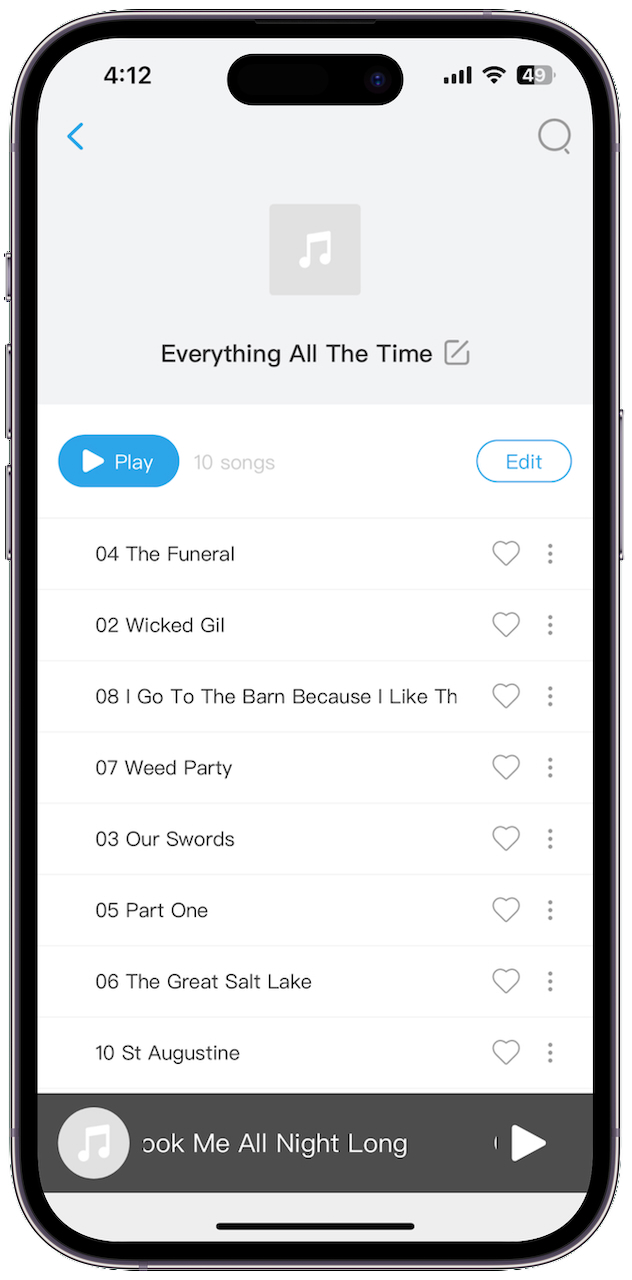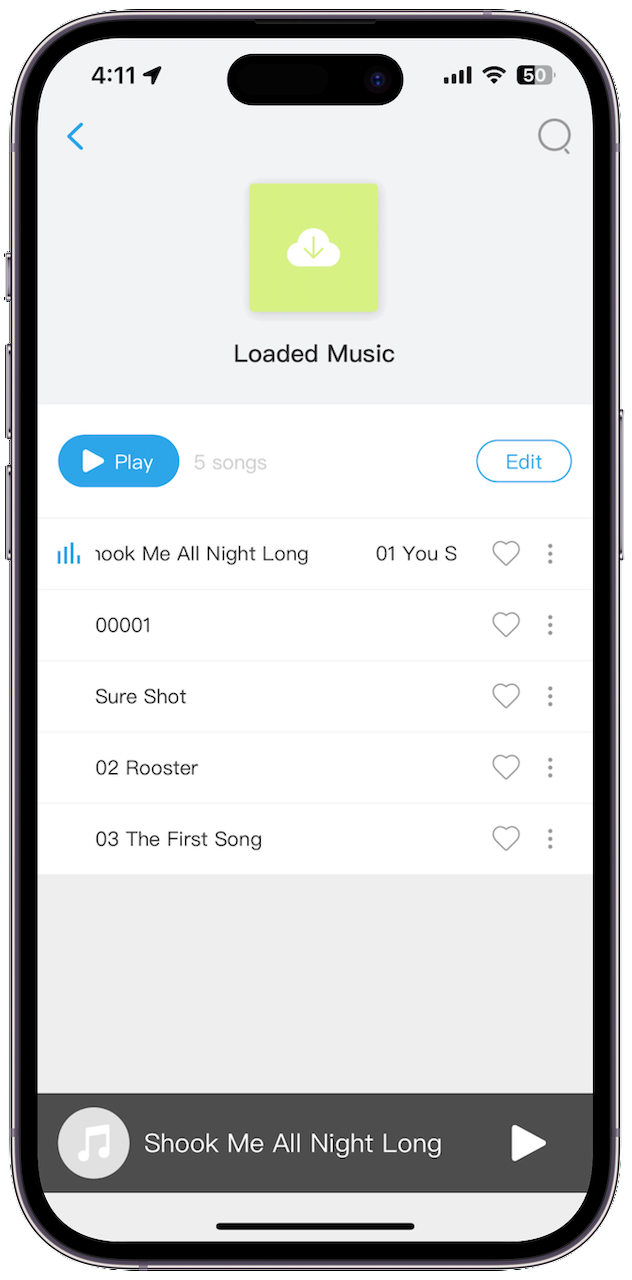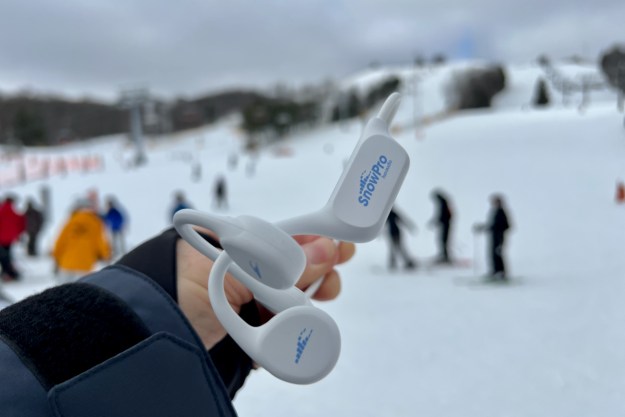
“The SnowPros sound terrible and miss the mark in almost every way for headphones I'd take on the slopes.”
- Comfortable fit around the ears
- Good call quality
- Secure neckband design
- IPX8 water and snow proof
- Expensive
- Tinny, thin sound quality
- No on-board EQ in the app
- Tiny physical buttons
- Playlist+ feature is ridiculous
- Open-ear design bad for wind noise
If you’re a skier or snowboarder looking to add music to your runs to enhance the experience (Crazy Train down a black diamond? Yes, please), it may not be as easy as popping in a set of earbuds and hitting the lift. Challenges for snow-sport-appropriate headphones include sound quality, resistance to wind noise, ease of use (especially with gloves or mitts on), and a secure and comfortable fit while beneath helmets and layers. And that’s not to mention extreme temperatures and lack of wireless connectivity on the mountain or in the backcountry.
While sports headphone maker H2O Audio considered these things with its SnowPro bone-conduction headphones, after spending several days on the slopes with them, my experience was a mixed bag of ups and mostly downs (pun intended). Considering their hefty $180 price, the SnowPros ultimately miss the mark in almost every way I find important for a set of headphones I would want to use while skiing. Here’s why.
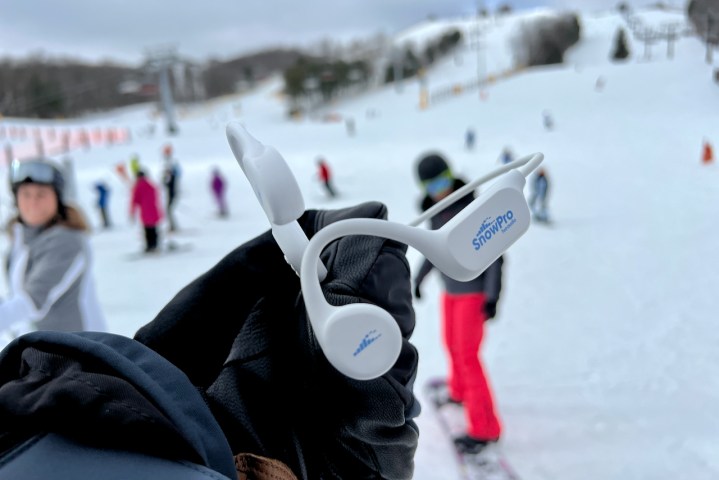
H2O SnowPro: design and Fit
The SnowPro headphones are similar to other H2O Audio bone conduction headphones, such as its popular Tri Pro Multi-Sport, which the company targets towards sports enthusiasts like swimmers, runners, and cyclists. H2O’s first headphones made and marketed specifically with snow sports in mind, the SnowPro headphones sport a white color (don’t drop them in the snow, you’ll never find them) but feature the same earhook design and neck band, and their hard plastic material feels sturdy and rugged. While they don’t roll up or collapse into a compact form, I didn’t have any issues stuffing them in my ski bag with my gloves and toque (as a Canadian, I’m legally forbidden to call it a beanie.) A case of some kind would have been a nice touch, though.
The SnowPros weigh next to nothing and can be worn for ages. I like the way that open-ear and bone-conduction headphones fit in general, and I can say the same about the SnowPros. They’re comfortable around the ears, the bone conduction ends sit on the cheekbones without pinching, and everything stays in place, even when shaking your head. If you weren’t skiing all day, you could definitely wear them all day. But I was skiing …
Fit problems arise with the SnowPros when bundling up for the slopes, which is not ideal since that’s what they’re meant for. Without a balaclava or neck warmer on, the low profile of the headphones fit well underneath my ski helmet’s earpads (more on this later), and the neckband didn’t interfere with the back of my helmet either. But zipping up the tall collar of my ski jacket, pulling a balaclava over the headphones, or anything that puts pressure on the neckband or the larger, rectangular headphone parts that sit behind the ear, can shift the position of the ear conductors.
I found that when bundled up, even moving my head shifted them, affecting the way they sounded (see our explainer on bone conduction for all the details). Adjusting them required constantly removing my gloves or undergoing a partial undressing process, which is not fun when it’s 15 below, er, 5 degrees (I’ll use Fahrenheit from here on out).
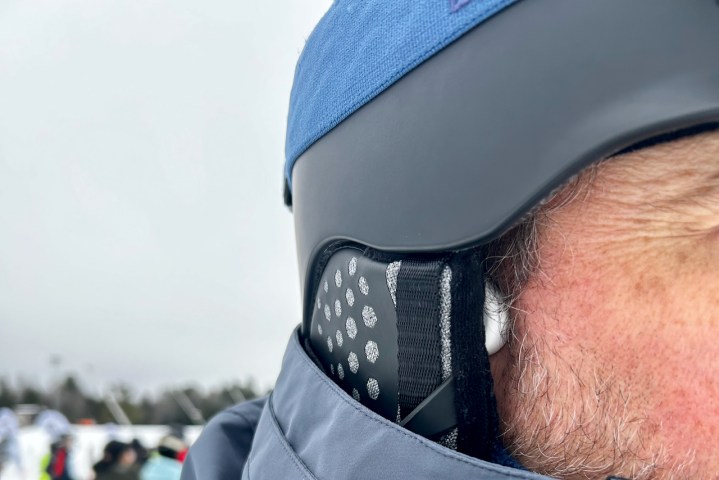
I did get to ski with them on a beautiful, 36-degree bluebird day, though, and with less gear obstructing them, the fit is much better, and the headphones shift less. If you tend to ski/ride in above-freezing climes, fit and shifting will be less of a concern.
However — and this is more of a commentary on a limitation of bone conduction headphones in general — when you’re ripping down a mountain at high speeds, wind noise is real. And without the ear seal that a pair of in-ear buds creates, with the SnowPros, the wind gets so loud in your open ears under your helmet that you can barely hear the music, at least temporarily. This brings me to how the SonwPros sound …
H2O SnowPro: sound quality
What the H2O SnowPros have going for them is that they’re a decent set of Bluetooth headphones that can play music and take calls from your connected phone, like any pair on our best wireless earbuds list. They also have 8GB of internal storage that allows you to leave your phone in the chalet and play a ton of MP3 files directly from the headphones.
After giving the SnowPro headphones a thorough listening in several different configurations on and off the slopes, and with a mountain of benefit-of-the-doubt that people will have different priorities and uses, here are my thoughts.
Out of the box, with no EQ adjustments, there was only one first impression to be made about how the SnowPros sound: terrible. If you’ve ever tried that old trick from back in the day of putting your smartphone in a bowl to amplify sound from its small speakers, this is how the SnowPros sounded at first.
Listening through Spotify, with the EQ set to “off” in the playback settings (like I would do for any headphone or speaker review), the low-end is non-existent, there are no dynamics to the sound, and everything sounds distant.
Bone conduction is not known for its rich bass, but the worst part was the highs, which are incredibly tinny, hissy, and sibilant on cymbals, “esses” in lyrics, and just about anything with a sharp tone.
I tried them with everything from Alice in Chains to Radiohead to Taylor Swift, Miles Davis, Black Sabbath, and Jay Z, and the results were the same. I was not expecting this from an almost $180 pair of headphones.
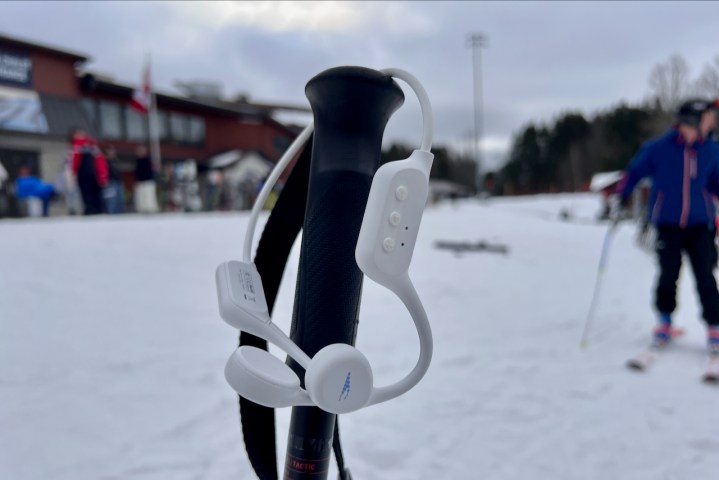
After much EQ adjustment in the Spotify app, things get better, but there is much room for improvement. Applying a “Rock” or “Flat” preset and then dialing the 15kHz slider way down helps a lot with all that sibilance. Boosting the 60Hz and 150Hz low-end sliders certainly adds more depth and substance, but going too far causes the conduction points to vibrate too much on your cheekbones, which tickles and can get uncomfortable. Turning the volume up too much can cause this effect, too, which you may have to do if you want the headphones to compete with all the wind your epic runs are bound to produce.
Bone-conduction headphones aren’t for everyone, and audiophiles need not apply — I get that. If your favorite music app has an EQ feature (Spotify, Apple Music, and Deezer do, while Tidal, Amazon Music, YouTube Music, and Qobuz do not), and you’re willing to spend the time tuning the SnowPros, it’s possible to get the SnowPro headphones sounding OK. But no one should have to work that hard to get a $180 pair of headphones to sound just OK.
Additionally, while the open-ear, bone conduction style of the SnowPros do make it easier and helpful for hearing the world around you (like screaming, runaway Jerrys barrelling towards you), don’t try talking to your significant other while music is playing — you won’t be able to hear much without turning the volume way down, which is easier said than done (more on that to come).
H2O SnowPro: call quality
One of the SnowPro features I was most curious about trying while on the slopes was making and taking calls. As someone who skis a lot with a young daughter, wife, and friends, I’m constantly risking dropping my phone from the lift while trying to text. Dictating a text or, better yet, calling my wife and kid, would be preferable. And with the Snow Pros paired to my iPhone, it was easy enough to do.
After what I just told you about how they sound with music, I was shocked with the sound quality and clarity — listening to my callers’ voices was better than a lot of higher-end earbuds I’ve tried. Wind noise aside, voices sounded full, clear, and not at all like the “phone voice” I’m used to. Why can’t its music playback sound this good?
On the other end, however, after questioning my wife and daughter, I was informed that with my ski helmet on, they could barely hear me. With it off, they could hear me much better, they said, although they did point out that it sounded like I was “far away.”
H2O SnowPro: playback and Playlist+
- 1. The connection screen
- 2. Choose your recording duration
- 3. Recording in progress
There are a couple of ways to listen to music on the SnowPro headphones: as a normal set of Bluetooth headphones paired to your phone and through your streaming services or as a standalone music player with 8GB of storage and playback controls.
The best way to use the SnowPros is, by far, the former. If you’re already a user of Bluetooth earbuds while skiing or boarding, the playback experience will be familiar: pair them and control the playback on your phone — I’ve found it easier to pull my phone from my jacket pocket on the lift or before a run than accessing touch or button controls on earbuds under my helmet ear coverings.
I made a few playlists on Spotify for my days skiing with the SnowPros, and the lackluster sound aside, popping my phone in and out of my jacket pocket wasn’t too big of a deal, and my touch-sensitive glove fingers made it relatively easy to control the playback. However, there are Bluetooth headphones that do all this, sound better, and don’t cost as much.
Using the SnowPro headphones as a standalone MP3 player, however, is … interesting. First, let me caveat this by saying if it’s essential that you use them without being connected to your phone (maybe you don’t like bringing your phone on the slopes) or are frequently out of wireless range for music streaming, then the SnowPro headphones might make more sense, but be warned …
The playback platform for the SnowPros is H2O Audio’s Playlist+ feature that lets you access and play music stored on the headphones using the tiny physical buttons on the outside of the right side of the headphones that sit behind your ear. I’m not sure what was more frustrating: having to take my gloves off and hunt under my helmet every time I wanted to play, stop, skip tracks, or navigate the folder menus, or actually loading music on the headphones in the first place.
Doing this can be done in one of two ways. First, you can connect the SnowPros to your computer via USB and drag and drop your MP3s to the headphones’ folders. This is by far the best way to do it. After a lot of trial and error, I was able to make sense of how to access the music I moved over, either as single MP3s or as entire albums within their own folders that you can — with a lot of clicking of tiny buttons — find. I learned that for playlists, you should rename your files with numbers at the front so it plays them in the order you want and not alphabetically.
- 1. A full album folder
- 2. A full album tracklist
- 3. Single song tracks
The other way is marketed by H2O as “like your old-school tape recorder,” and they are not kidding. Playlist+ lets you record music from your phone’s Bluetooth audio connection and a streaming service like Spotify, through the not-great H2O app, live, like it was 1989 and you’re making a mixtape for your crush.
Using the app and the headphones paired to your phone, you have to start playing a song from your streaming service, then jump back to the H2O app and hit record (you can also do this via the headphones’ physical buttons). The song is recorded, live, to the SnowPro’s 8GB storage, however it may sound. Remember the EQing I mentioned earlier? My best results were from Spotify with my EQ tweaks made, but if I used, say, Tidal, I got that un-equalized, tinny sound (through no fault of Tidal’s) — the H2O app has no built-in EQ of its own for recording or playback. And unless you have a pile of MP3s on a drive somewhere (H2O says it also supports “most audio formats, including the Apple iTunes music format (.m4a),” this is probably the only way you’ll have to load the SnowPro up with music. So, settle in if you’re recording a lot of songs or a long playlist; remember, it must be done live.
If you stop, adjust the volume, or skip a track, it’s recorded to the headphones. And unless you stop and create a new recording after every song, your playlist will be one continuous file, so, no skipping tracks when you play it back. Additionally, the new single files recorded are named with a number like “00001,” so when they’re added to your single track list, they can mess with the order of your existing numbered side-loaded tracks. And another thing, when starting a new recording, because you have to press play on the song before you switch to the H2O app to record, the first bit of every new recording/song gets cut off. Making a mixtape was easier.
H2O SnowPro: the bottom line
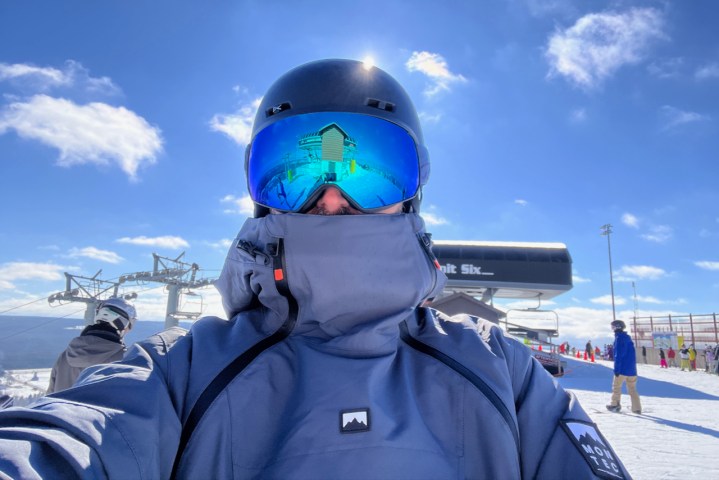
The H2O SnowPro headphones are a cold mess. I tried to like them, I really did, because I like the idea of skiing while enjoying some music. If you’re a person with endless patience or who doesn’t mind just hitting play and listening to whatever is funneled into your ear holes while you ride, and sound quality isn’t a priority, then roll the dice — battery life isn’t great at just five hours, but they are rugged as hell (IPX8), and you can even take them in the hot tub for some après ski.
$180 is a jagged pill to swallow, though, considering their drawbacks. That said, there aren’t a lot of other options out there for snow sports-specific headphones and one of the closest competitors we could find, the Shokz OpenRun, is around the same price — their IP67 rating is also still OK for snow, though. You could also grab a pair of simple wired $20 EarPods (or 10) or other wired earbuds like I see all kinds of skiers sporting under their helmets without worrying about dropping them from the chairlift. Most ski jackets have holes for the wires to run through the pockets. The tech is simple, and they honestly are a good bet until someone comes up with a better solution.
At the end of the ski day, however, I spent far too much time fussing with the SnowPro headphones at home and, more importantly, on the cold, cold mountain, making me want to just leave them in the chalet where they belong.

